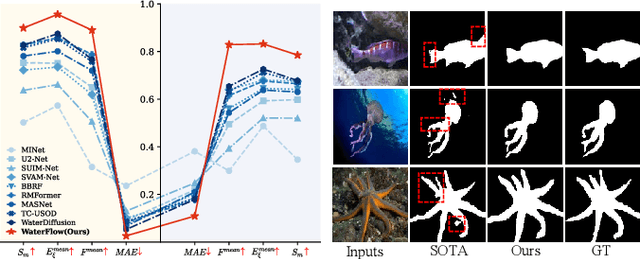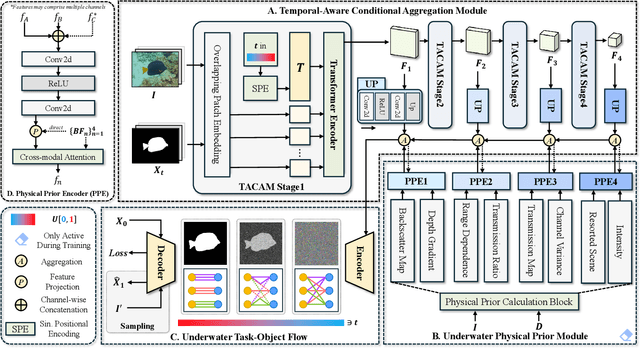Object Detection
Object detection is a computer vision task in which the goal is to detect and locate objects of interest in an image or video. The task involves identifying the position and boundaries of objects in an image, and classifying the objects into different categories. It forms a crucial part of vision recognition, alongside image classification and retrieval.
Papers and Code
Kinematic Analysis and Integration of Vision Algorithms for a Mobile Manipulator Employed Inside a Self-Driving Laboratory
Oct 21, 2025Recent advances in robotics and autonomous systems have broadened the use of robots in laboratory settings, including automated synthesis, scalable reaction workflows, and collaborative tasks in self-driving laboratories (SDLs). This paper presents a comprehensive development of a mobile manipulator designed to assist human operators in such autonomous lab environments. Kinematic modeling of the manipulator is carried out based on the Denavit Hartenberg (DH) convention and inverse kinematics solution is determined to enable precise and adaptive manipulation capabilities. A key focus of this research is enhancing the manipulator ability to reliably grasp textured objects as a critical component of autonomous handling tasks. Advanced vision-based algorithms are implemented to perform real-time object detection and pose estimation, guiding the manipulator in dynamic grasping and following tasks. In this work, we integrate a vision method that combines feature-based detection with homography-driven pose estimation, leveraging depth information to represent an object pose as a $2$D planar projection within $3$D space. This adaptive capability enables the system to accommodate variations in object orientation and supports robust autonomous manipulation across diverse environments. By enabling autonomous experimentation and human-robot collaboration, this work contributes to the scalability and reproducibility of next-generation chemical laboratories
* International Journal of Intelligent Robotics and Applications 2025
Hybrid Genetic Algorithm for Optimal User Order Routing: Multi-Objective Solver Optimization in CoW Protocol Batch Auctions
Oct 24, 2025CoW Protocol batch auctions aggregate user intents and rely on solvers to find optimal execution paths that maximize user surplus across heterogeneous automated market makers (AMMs) under stringent auction deadlines. Deterministic single-objective heuristics that optimize only expected output frequently fail to exploit split-flow opportunities across multiple parallel paths and to internalize gas, slippage, and execution risk constraints in a unified search. We apply evolutionary multi-objective optimization to this blockchain routing problem, proposing a hybrid genetic algorithm (GA) architecture for real-time solver optimization that combines a production-grade, multi-objective NSGA-II engine with adaptive instance profiling and deterministic baselines. Our core engine encodes variable-length path sets with continuous split ratios and evolves candidate route-and-volume allocations under a Pareto objective vector F = (user surplus, -gas, -slippage, -risk), enabling principled trade-offs and anytime operation within the auction deadline. An adaptive controller selects between GA and a deterministic dual-decomposition optimizer with Bellman-Ford based negative-cycle detection, with a guarantee to never underperform the baseline. The open-source system integrates six protection layers and passes 8/8 tests, validating safety and correctness. In a 14-stratum benchmark (30 seeds each), the hybrid approach yields absolute user-surplus gains of approximately 0.40-9.82 ETH on small-to-medium orders, while large high-fragmentation orders are unprofitable across gas regimes. Convergence occurs in about 0.5 s median (soft capped at 1.0 s) within a 2-second limit. We are not aware of an openly documented multi-objective GA with end-to-end safety for real-time DEX routing.
REVE: A Foundation Model for EEG -- Adapting to Any Setup with Large-Scale Pretraining on 25,000 Subjects
Oct 24, 2025Foundation models have transformed AI by reducing reliance on task-specific data through large-scale pretraining. While successful in language and vision, their adoption in EEG has lagged due to the heterogeneity of public datasets, which are collected under varying protocols, devices, and electrode configurations. Existing EEG foundation models struggle to generalize across these variations, often restricting pretraining to a single setup, resulting in suboptimal performance, in particular under linear probing. We present REVE (Representation for EEG with Versatile Embeddings), a pretrained model explicitly designed to generalize across diverse EEG signals. REVE introduces a novel 4D positional encoding scheme that enables it to process signals of arbitrary length and electrode arrangement. Using a masked autoencoding objective, we pretrain REVE on over 60,000 hours of EEG data from 92 datasets spanning 25,000 subjects, representing the largest EEG pretraining effort to date. REVE achieves state-of-the-art results on 10 downstream EEG tasks, including motor imagery classification, seizure detection, sleep staging, cognitive load estimation, and emotion recognition. With little to no fine-tuning, it demonstrates strong generalization, and nuanced spatio-temporal modeling. We release code, pretrained weights, and tutorials to support standardized EEG research and accelerate progress in clinical neuroscience.
Automated Detection of Visual Attribute Reliance with a Self-Reflective Agent
Oct 24, 2025When a vision model performs image recognition, which visual attributes drive its predictions? Detecting unintended reliance on specific visual features is critical for ensuring model robustness, preventing overfitting, and avoiding spurious correlations. We introduce an automated framework for detecting such dependencies in trained vision models. At the core of our method is a self-reflective agent that systematically generates and tests hypotheses about visual attributes that a model may rely on. This process is iterative: the agent refines its hypotheses based on experimental outcomes and uses a self-evaluation protocol to assess whether its findings accurately explain model behavior. When inconsistencies arise, the agent self-reflects over its findings and triggers a new cycle of experimentation. We evaluate our approach on a novel benchmark of 130 models designed to exhibit diverse visual attribute dependencies across 18 categories. Our results show that the agent's performance consistently improves with self-reflection, with a significant performance increase over non-reflective baselines. We further demonstrate that the agent identifies real-world visual attribute dependencies in state-of-the-art models, including CLIP's vision encoder and the YOLOv8 object detector.
Mixing Configurations for Downstream Prediction
Oct 22, 2025Humans possess an innate ability to group objects by similarity, a cognitive mechanism that clustering algorithms aim to emulate. Recent advances in community detection have enabled the discovery of configurations -- valid hierarchical clusterings across multiple resolution scales -- without requiring labeled data. In this paper, we formally characterize these configurations and identify similar emergent structures in register tokens within Vision Transformers. Unlike register tokens, configurations exhibit lower redundancy and eliminate the need for ad hoc selection. They can be learned through unsupervised or self-supervised methods, yet their selection or composition remains specific to the downstream task and input. Building on these insights, we introduce GraMixC, a plug-and-play module that extracts configurations, aligns them using our Reverse Merge/Split (RMS) technique, and fuses them via attention heads before forwarding them to any downstream predictor. On the DSN1 16S rRNA cultivation-media prediction task, GraMixC improves the R2 score from 0.6 to 0.9 across multiple methods, setting a new state of the art. We further validate GraMixC on standard tabular benchmarks, where it consistently outperforms single-resolution and static-feature baselines.
Beat Detection as Object Detection
Oct 16, 2025Recent beat and downbeat tracking models (e.g., RNNs, TCNs, Transformers) output frame-level activations. We propose reframing this task as object detection, where beats and downbeats are modeled as temporal "objects." Adapting the FCOS detector from computer vision to 1D audio, we replace its original backbone with WaveBeat's temporal feature extractor and add a Feature Pyramid Network to capture multi-scale temporal patterns. The model predicts overlapping beat/downbeat intervals with confidence scores, followed by non-maximum suppression (NMS) to select final predictions. This NMS step serves a similar role to DBNs in traditional trackers, but is simpler and less heuristic. Evaluated on standard music datasets, our approach achieves competitive results, showing that object detection techniques can effectively model musical beats with minimal adaptation.
Structured Universal Adversarial Attacks on Object Detection for Video Sequences
Oct 16, 2025Video-based object detection plays a vital role in safety-critical applications. While deep learning-based object detectors have achieved impressive performance, they remain vulnerable to adversarial attacks, particularly those involving universal perturbations. In this work, we propose a minimally distorted universal adversarial attack tailored for video object detection, which leverages nuclear norm regularization to promote structured perturbations concentrated in the background. To optimize this formulation efficiently, we employ an adaptive, optimistic exponentiated gradient method that enhances both scalability and convergence. Our results demonstrate that the proposed attack outperforms both low-rank projected gradient descent and Frank-Wolfe based attacks in effectiveness while maintaining high stealthiness. All code and data are publicly available at https://github.com/jsve96/AO-Exp-Attack.
D2D: Detector-to-Differentiable Critic for Improved Numeracy in Text-to-Image Generation
Oct 22, 2025Text-to-image (T2I) diffusion models have achieved strong performance in semantic alignment, yet they still struggle with generating the correct number of objects specified in prompts. Existing approaches typically incorporate auxiliary counting networks as external critics to enhance numeracy. However, since these critics must provide gradient guidance during generation, they are restricted to regression-based models that are inherently differentiable, thus excluding detector-based models with superior counting ability, whose count-via-enumeration nature is non-differentiable. To overcome this limitation, we propose Detector-to-Differentiable (D2D), a novel framework that transforms non-differentiable detection models into differentiable critics, thereby leveraging their superior counting ability to guide numeracy generation. Specifically, we design custom activation functions to convert detector logits into soft binary indicators, which are then used to optimize the noise prior at inference time with pre-trained T2I models. Our extensive experiments on SDXL-Turbo, SD-Turbo, and Pixart-DMD across four benchmarks of varying complexity (low-density, high-density, and multi-object scenarios) demonstrate consistent and substantial improvements in object counting accuracy (e.g., boosting up to 13.7% on D2D-Small, a 400-prompt, low-density benchmark), with minimal degradation in overall image quality and computational overhead.
WaterFlow: Explicit Physics-Prior Rectified Flow for Underwater Saliency Mask Generation
Oct 14, 2025



Underwater Salient Object Detection (USOD) faces significant challenges, including underwater image quality degradation and domain gaps. Existing methods tend to ignore the physical principles of underwater imaging or simply treat degradation phenomena in underwater images as interference factors that must be eliminated, failing to fully exploit the valuable information they contain. We propose WaterFlow, a rectified flow-based framework for underwater salient object detection that innovatively incorporates underwater physical imaging information as explicit priors directly into the network training process and introduces temporal dimension modeling, significantly enhancing the model's capability for salient object identification. On the USOD10K dataset, WaterFlow achieves a 0.072 gain in S_m, demonstrating the effectiveness and superiority of our method. The code will be published after the acceptance.
Integrated Massive Communication and Target Localization in 6G Cell-Free Networks
Oct 16, 2025This paper presents an initial investigation into the combination of integrated sensing and communication (ISAC) and massive communication, both of which are largely regarded as key scenarios in sixth-generation (6G) wireless networks. Specifically, we consider a cell-free network comprising a large number of users, multiple targets, and distributed base stations (BSs). In each time slot, a random subset of users becomes active, transmitting pilot signals that can be scattered by the targets before reaching the BSs. Unlike conventional massive random access schemes, where the primary objectives are device activity detection and channel estimation, our framework also enables target localization by leveraging the multipath propagation effects introduced by the targets. However, due to the intricate dependency between user channels and target locations, characterizing the posterior distribution required for minimum mean-square error (MMSE) estimation presents significant computational challenges. To handle this problem, we propose a hybrid message passing-based framework that incorporates multiple approximations to mitigate computational complexity. Numerical results demonstrate that the proposed approach achieves high-accuracy device activity detection, channel estimation, and target localization simultaneously, validating the feasibility of embedding localization functionality into massive communication systems for future 6G networks.
 Add to Chrome
Add to Chrome Add to Firefox
Add to Firefox Add to Edge
Add to Edge